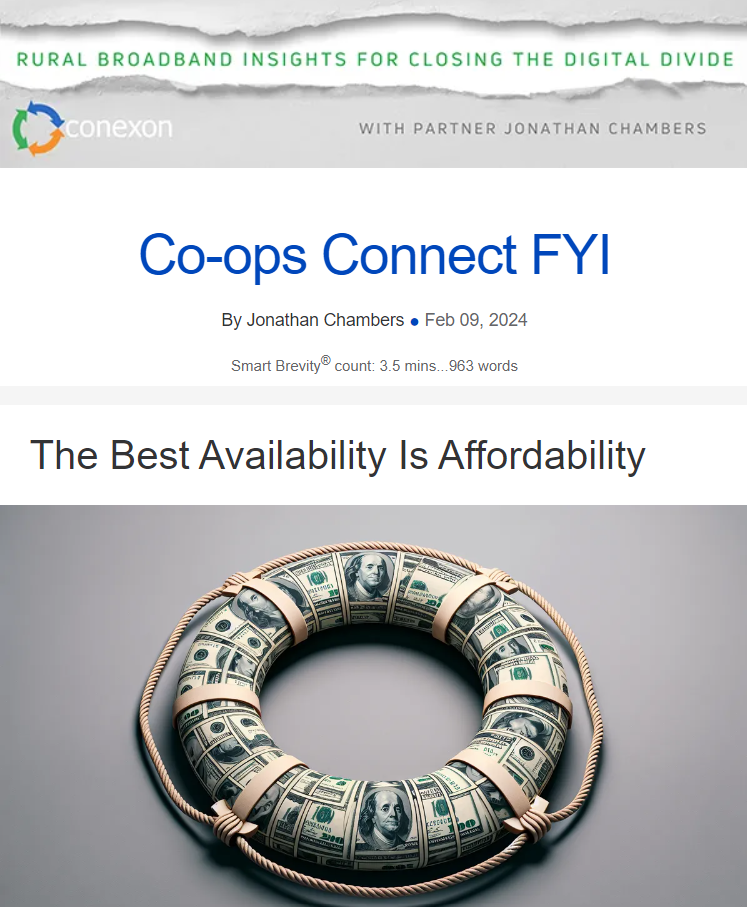The Best Availability Is Affordability
February 9, 2024
There is an old saying in sports that the best ability is availability.
For broadband service: The best availability is affordability.
As I mentioned in the Jan. 12 newsletter, the Affordable Connectivity Program (ACP) will soon run out of cash.
- As of yesterday, the program is no longer accepting new participants.
- While some are seeking more funding from Congress, any new funding will not last through the year.
What’s next:
- Next week, I am submitting a petition to the Federal Communications Commission (“FCC” or “the Commission”) seeking a rulemaking to modify the Lifeline program to assist low-income households in affording residential broadband.
- I will ask the FCC to put this petition out for public comment under its expedited procedures, which will enable the FCC to make decisions in time to help low-income households when they lose their ACP subsidy.
The Broader Context
Over the past decade, Conexon and our rural electric cooperative partners have invested billions of dollars into rural fiber-to-the-premise networks in unserved and underserved areas.
- Collectively, we participated in:
— The FCC’s Connect America Fund Phase II (CAF II) through the Rural Electric Cooperative Consortium (RECC);
— The Rural Digital Opportunity Fund (RDOF) Auctions also through the RECC;
— The CARES Act; and
— The American Rescue Plan Act funding for broadband.
- We intend to participate in state BEAD programs, too.
Why it matters:
A large number of Conexon’s customers and the customers of our rural electric cooperative partners are eligible for the ACP (and Lifeline program) benefits.
The ACP and the BEAD program were meant to work together.
- Ending ACP just as BEAD launches will weaken the financial case for the deployment of rural broadband.
- Fortunately, Section 254 of the 1996 Telecommunications Act gives the Commission authority to ensure broadband services are available and affordable to low-income households.
The Quick and Meaningful Fix
Conexon is submitting its petition for a targeted purpose.
Currently, companies that participate in the Lifeline program receive $9.25 per month to serve households that are near or below the poverty level.
The $9.25/month subsidy has long been considered insufficient to make broadband affordable for those living near or below the poverty level.
With the ACP out of funds, Conexon is asking the Commission to act quickly to adjust the Lifeline program so low-income households in most need of subsidized residential broadband service can receive an enhanced Lifeline subsidy:
- Our proposed enhanced subsidy is the same as the ACP subsidy: $30 per month (rather than $9.25 per month).
- This enhanced subsidy would be akin to the Lifeline subsidy for service to tribal lands, which is currently $34.25 per month.
The bottom line:
Conexon will ask the Commission to act on the proposed Lifeline reforms to achieve two objectives:
1. Speedy relief
2. Sustainable reforms
Why Conexon’s Proposed Fix Can Work
To get speedy relief, Conexon proposes the Commission initially amend only the subsidy amounts in the Lifeline program.
Using existing administrative mechanisms, the Commission can leave many elements of Lifeline unchanged, including:
- The eligibility criteria for households
- The administrative procedures for participating carriers
- The limitations of one subsidy per household
- Other procedures that have protected the integrity of the program over the course of the past 40 years
To ensure the sustainability of these reforms, Conexon believes it is ill-advised to reestablish ACP as the Lifeline program.
- ACP’s level of expenditure — $1 billion every month — is unsustainable for the Universal Service Fund.
- Without major reform to the Universal Service Fund contribution methodology, ACP expenditure levels cannot be absorbed by the Lifeline program.
Later, the Commission always can take up broader reforms of the Universal Service programs.
- The Commission will be able to reduce expenditures in various high-cost programs as the provisions of BEAD for rural broadband are implemented.
- The Commission may also wish to consider contribution reform, since all FCC Universal Service funding comes from shrinking interstate and international telecommunications revenues.
Consideration of these larger reforms should not slow the delivery of relief right now.
To be clear, I recognize that the limited reform I am proposing will not deliver a subsidy to all current ACP recipients. It will help those most in need.
How Conexon’s Proposed Fix Works
Limiting Lifeline reforms today to a few elements is smart and beneficial.
Conexon is proposing these specific Lifeline reforms:
1. Enhancing the $9.25 Lifeline benefit by $20.75, for a total benefit of $30 (the same as the lower-tier ACP benefit).
2. Adopting NTIA’s definition of broadband in BEAD for this enhanced benefit, i.e., 100/20 Mbps fixed wireline or wireless service at a household.
Eligibility for the enhanced Lifeline benefit would remain unchanged at 135% of the poverty level.
And, assuming the Commission transparently releases the data regarding ACP expenditures for public review, it should seek comment on enhanced subsidies for other low-income households, including households at 150% and 200% of the poverty level, other forms of broadband and telecommunications services, as well as a higher benefit for low-income households in high-cost areas.
The final word:
I have no illusions about the prospects for reform.
- To be clear, the FCC:
— Is not required to act.
— Is not required to use expedited procedures.
— Is not required to initiate a rulemaking.
— Is not required even to seek comment on this petition.
— Is not required to use its authority to help low-income households hurt by the loss of ACP benefits.
- Indeed, the FCC may ignore the petition altogether.
Nevertheless, I think it is worth a sincere effort to help those most in need – including by petitioning those empowered to make change with a ready solution.
